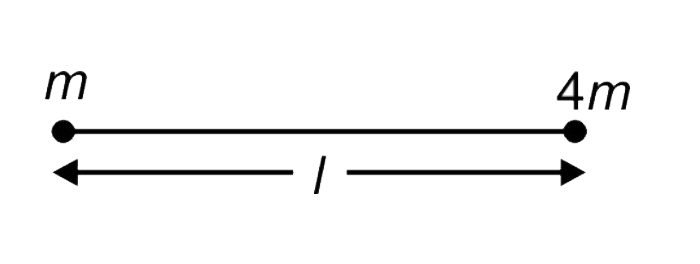Two spheres of masses 16 kg and 4 kg are separated by a distance 30 m on a table. Then, the distance from sphere of mass 16 kg at which the net gravitational force becomes zero is
10 m
20 m
15 m
5 m
The correct Answer is:B
To find the distance from the sphere of mass 16 kg at which the net gravitational force becomes zero, we can follow these steps:
Step 1: Understand the setup
We have two spheres:
- Mass m1=16kg
- Mass m2=4kg
They are separated by a distance of d=30m.
Step 2: Define the point where the gravitational force is zero
Let x be the distance from the 16 kg mass where the net gravitational force is zero. Thus, the distance from the 4 kg mass to this point will be 30−x.
Step 3: Set up the gravitational force equations
The gravitational force exerted by the 16 kg mass at point P is given by:
F1=G⋅m1x2
The gravitational force exerted by the 4 kg mass at point P is given by:
F2=G⋅m2(30−x)2
Step 4: Set the forces equal to each other
For the net gravitational force to be zero at point P:
F1=F2
This gives us:
G⋅16x2=G⋅4(30−x)2
We can cancel G from both sides:
16x2=4(30−x)2
Step 5: Cross-multiply to solve for x
Cross-multiplying gives:
16(30−x)2=4x2
Expanding this:
16(900−60x+x2)=4x2
14400−960x+16x2=4x2
Rearranging the equation:
16x2−4x2−960x+14400=0
12x2−960x+14400=0
Step 6: Simplify the equation
Dividing the entire equation by 12:
x2−80x+1200=0
Step 7: Use the quadratic formula to solve for x
Using the quadratic formula x=−b±√b2−4ac2a:
Here, a=1, b=−80, and c=1200:
x=80±√(−80)2−4⋅1⋅12002⋅1
Calculating the discriminant:
x=80±√6400−48002
x=80±√16002
x=80±402
This gives us two potential solutions:
x=1202=60andx=402=20
Step 8: Determine the valid solution
Since x=60 is greater than the distance between the two masses (30 m), it is not a valid solution. Thus, the only valid solution is:
x=20m
Final Answer
The distance from the sphere of mass 16 kg at which the net gravitational force becomes zero is 20m.
---
We have two spheres:
- Mass m1=16kg
- Mass m2=4kg
They are separated by a distance of d=30m.
Let x be the distance from the 16 kg mass where the net gravitational force is zero. Thus, the distance from the 4 kg mass to this point will be 30−x.
The gravitational force exerted by the 16 kg mass at point P is given by:
F1=G⋅m1x2
The gravitational force exerted by the 4 kg mass at point P is given by:
F2=G⋅m2(30−x)2
For the net gravitational force to be zero at point P:
F1=F2
This gives us:
G⋅16x2=G⋅4(30−x)2
We can cancel G from both sides:
16x2=4(30−x)2
Cross-multiplying gives:
16(30−x)2=4x2
Expanding this:
16(900−60x+x2)=4x2
14400−960x+16x2=4x2
Rearranging the equation:
16x2−4x2−960x+14400=0
12x2−960x+14400=0
Dividing the entire equation by 12:
x2−80x+1200=0
Using the quadratic formula x=−b±√b2−4ac2a:
Here, a=1, b=−80, and c=1200:
x=80±√(−80)2−4⋅1⋅12002⋅1
Calculating the discriminant:
x=80±√6400−48002
x=80±√16002
x=80±402
This gives us two potential solutions:
x=1202=60andx=402=20
Since x=60 is greater than the distance between the two masses (30 m), it is not a valid solution. Thus, the only valid solution is:
x=20m
The distance from the sphere of mass 16 kg at which the net gravitational force becomes zero is 20m.
Topper's Solved these Questions
Similar Questions
Two point masses 1 kg and 4 kg are separated by a distance of 10 cm. Find gravitational potential energy of the two point masses.
View SolutionTwo point masses m and 4 m are seperated by a distance d on a line . A third point mass m0 is to be placed at a point on the line such that the net gravitational force on it zero .

The distance of that point from the m mass is
View Solution
Knowledge Check
Two identical spheres each of mass M and Radius R are separated by a distance 10R. The gravitational force on mass m placed at the midpoint of the line joining the centres of the spheres is
AzeroB2GMm25R2CGMm25R2DGMm100R2
Two spheres each of mass 104 kg are separated by a distance of 100 m. What will be the gravitationel potential energy of the system?
View SolutionTwo particles having masses m and 4m are separated by distance l. The distance of the centre of mass from m is x1andx2 is the distance of point at which gravitational field intensity is zero. Find the value of x1x2

View SolutionTwo particles A and B having masses M and 4M respectively are kept at a distance 2.73 m apart. Another small particle of mass m is to be placed so that the net gravitational force on it is zero. What will be its distance from body A ?
View SolutionTwo bodies of masses 10 kg and 100 kg are seperated by a distance of 2 m. The gravitational potential at the mid-point of the line joining the two bodies is:
View SolutionTwo bodies of masses 100kg and 10,000kg are at a distance 1m part. At which point on the line joining them will the resultant gravitational field intensity be zero?
View SolutionTwo bodies of mass M and 4M kept at a distance y apart. Where should a small particle of mass m be placed from M so that the net gravitational force on it is zero
View SolutionTwo particles of masses 0.2 kg and 0.8 kg are separated by 12 cm. At which point from the 0.2 kg particle, gravitational field intensity due to the two particles is zero?
View Solution

